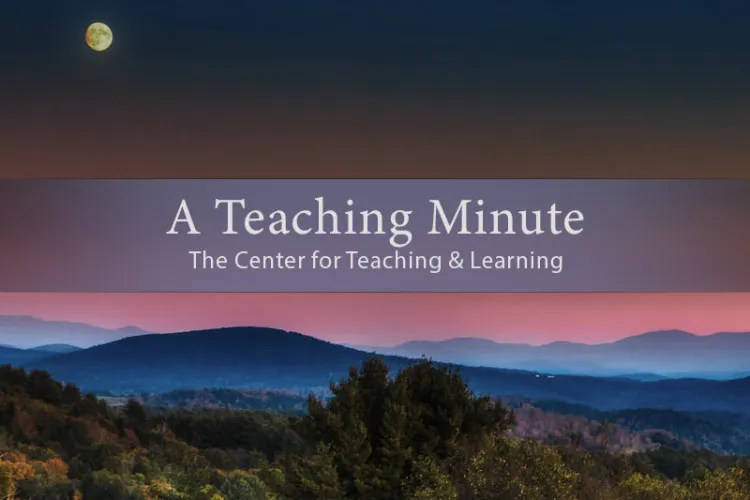
UDL – Supporting Emotional Capacity
Friday, 9/26/2025
This semester at the CTL, our theme is Universal Design for Learning (UDL). Each Teaching Minute will focus on one aspect of the UDL principle and we're sharing a few options for small adjustments you can make to your teaching. We continue with the principle of Engagement, this time highlighting the Emotional Capacity Guideline.
Why Emotional Capacity Matters
We all know that students experience a range of emotions in academic settings. Curiosity, hope, enjoyment, or pride as well as boredom, anxiety, frustration, or discouragement can impact their ability to learn, their behavior in the classroom, and may even affect whether they'll persist in college. Recognizing and regulating feelings is a skill that will serve students in their learning, their work, and in all aspects of their lives.
From the UDL guidelines on emotional capacity:
“While many individuals develop regulatory skills and practices on their own, either by trial and error or by observing successful adults, many others can benefit from more explicit supports.”
The UDL guidelines offer ways we can help students become more self-regulated, compassionate, and reflective learners. By teaching reflection, we can help them to understand their own, personal, best ways of learning, to set (and meet) learning goals, and to develop self-awareness and awareness of others.
Practical Ideas to Try
Here are a few strategies you could experiment with – try just one to start:
- One writing prompt that invites a connection to the class content and encourages self-reflection is: “Think about a concept, discussion, or experience from this course that challenged your previous assumptions or changed your perspective. Describe what you thought before, what you encountered in the course, and how your thinking has evolved.” (In “Dig Deeper” below, there are more resources about reflective writing.)
- Offer other options for reflection—not all thinking needs to be expressed in text. Consider asking them to:
- Make online concept maps.
- Hand-draw a picture or a “map” of what they're learning, thinking, or feeling.
- Post to a discussion topic an image or meme that metaphorically represents how they feel, e.g. a sunrise, a mudslide, or a sleeping kitten hanging half-off of the couch and briefly describe why they chose it.
- Form pairs and ask them to talk about a prompt, such as, “What was something that challenged you today and how did you respond to that challenge?” or “Talk about one thing you learned today.” or “Share something that is confusing and make a plan for how you might find clarity.”
- Reflection takes time. During in-class discussions, providing some wait-time for students to reflect before responding to your questions, or having them do a 2-minute write to gather their thoughts first, are practices to elicit deeper responses. Alternatively, have them post reflections in Brightspace Discussions or Yellowdig so that all students have a chance to participate.
- Supporting students' metacognition on the CTL website offers ideas for reflection around major assignments, classroom check-ins, and helping students track their own learning.
- Invite student feedback, mid-semester, about what’s helping their learning and what’s causing confusion. “Seeking Formative Feedback from Students” is a CTL workshop on this topic:
Tuesday, October 7, 10am - 11am
Thursday, October 16, 11am - 12pm - Collective reflection encourages social learning and builds relationships among students. If you have group projects, in addition to (or instead of) a more formal peer evaluation, schedule class time for a group debrief session, providing prompts that ask them to describe how they collaborated, how their work aligned with assignment goals, and what they might consider for future projects.
Dig Deeper
We've collected a variety of interesting resources on this topic:
- University of Minesota, Using Reflective Writing to Deepen Student Learning – This page looks closely at the value of reflective writing assignments, and it shares numerous examples, tools, and strategies instructors can explore.
- University of Baltimore Student Reflection: What and Why? – This brief read discusses how reflection isn't “touchy-feely,” but is “decidedly educational” and “must be facilitated by faculty,” offering useful tools and techniques.
- From College Teaching, “How Emotion Matters in Four Key Relationships in Teaching and Learning in Higher Education” (requires UVM login) by Professor Kathleen M. Quinlan, Director of the Centre for the Study of Higher Education at the University of Kent – This paper isn't UDL-based, but is an interesting read about the purported growing interest in emotion in higher education.
- California Collaborative for Educational Excellence, UDL and Social Emotional Learning – In this series of short videos, Lisa Bosio from Novak Education describes the neurology of emotion, the necessity of flexible supports, and the building of student capacity for self regulation. Included are concrete ideas instructors can implement.
- Columbia University's CTL Podcast, Dead Ideas in Teaching & Learning – This episode, “The Present Professor with Liz Norell,” explores how the “dead idea” that “the world outside the classroom shouldn't impact the world inside the classroom; that students are exclusively intellectual beings when they step across the threshhold of a classroom space” is defunct, and that practicing presence (for both instructors and students) is key to engagement and learning. Direct link to the episode [Opens in player] Transcript [PDF].
If you want to talk through how UDL could work in your own course, the CTL team is here to brainstorm ideas, share strategies, or connect with upcoming workshops. Schedule a consultation with us to keep the conversation going!
Happy teaching!
Center for Teaching & Learning
www.uvm.edu/ctl
ctl@uvm.edu